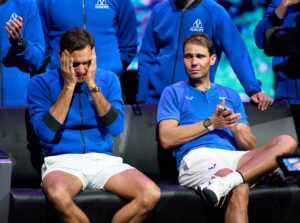Last weekend Argentina, the greatest tennis nation never to win the Davis Cup, finally broke its duck, defeating Croatia in a thrilling team performance. It also was also a personal triumph for Juan Martín del Potro who, after so many injury-ravaged years, finally has male tennis’ greatest team trophy to put alongside the US Open he won in 2009. However, Argentina, for all their heroics in Zagreb, will have to win the tournament many times more before they can begin to compare with the greatest of all Davis Cup teams. Here are the finest five, in ascending order.
- SPAIN (2000-20012)
It is remarkable to consider that Spain, one of the greatest tennis nations and which had already produced champions such as 60s great Manuel Santana, did not win its first Davis Cup until the year 2000, when clay court specialists such as Alberto Costa and Juan Carlos Ferrero led them to a famous win over an Australia side featuring Lleyton Hewitt and Pat Rafter, who were more at home on grass or hard courts. That victory lit the spark for more than a decade of Spanish domination of the Davis Cup, with five wins in this period (including three wins in four years between 2008 and 2011) and a further two runners-up places. A mainstay for much of this period was Rafael Nadal, who first came to global attention by defeating the USA’s Andy Roddick in the 2004 final when he was only 18. However, it was the sheer depth of Spanish men’s tennis at this time that ultimately swept all before it, with the likes of David Ferrer, Fernando Verdasco, Tommy Robredo and Feliciano Lopez thriving even in the periods when Nadal was absent, most notably in the 2008 final away in Argentina, one of the four finals that Argentina would lose before finally triumphing this year.
- USA (1968-1972)
It is only fitting that the USA is represented twice on this list, because with 32 wins overall it just shades Australia (which has 28 wins) as the most successful Davis Cup nation. There have been many periods of US success, but the team of the late 1960s and early 1970s, which won five titles in a row with all-time greats such as Arthur Ashe and Stan Smith in the vanguard, merits fourth place on this list–just ahead, for example, of the team of the late 1970s and early 1980s, led by John McEnroe, which won four titles in five years. Intriguingly, Romania, led by the princely Ilie Nastase and backed up by a young Ion Tiriac (who would later go on to oversee Boris Becker’s breakthrough in the 1980s as a manager and coach), were the beaten finalists in three of these five years, with Smith and Nastase reprising their epic Wimbledon final of 1972 in the Davis Cup finals of 1972 and 1973. Unfortunately for Nastase, on each occasion Smith–and the USA–triumphed
3. FRANCE (1927-1932)
The third greatest Davis Cup team statistically is undoubtedly the most romantic Davis Cup team, for this great French side, which won six titles in a row, did so much to globalize the game, turning it from being largely a game of the English-speaking world into a truly world sport. The story of French men’s tennis really began in 1925, when France lost to the all-conquering Americans (see No. 2, below) in Philadelphia. They would succumb again the following year, but in 1927 they made it third time lucky with a heroically narrow 3-2 victory. The victory of “Les Musquetaires” (or “the Philadelphia Four”, as they were initially hailed in America) of René Lacoste, Jean Borotra, Henri Cochet and Jacques Brugnon necessitated the building of a new and much larger French national stadium at Roland Garros, named after an early French aviator and WWI fighter pilot (which was in keeping with the Transatlantic feel of the Davis Cup at this time, when air travel really began). France would win five more times on home soil, cementing their tennis immortality and in the process transforming tennis into one of France’s most popular sports, a position it retains to this day.
- USA (1920-26)
It is one of the great ironies of Davis Cup history that the fabulous French side of the late 1920s and early 1930s are remembered so much more today than the USA team they supplanted at the top of the game, which was actually even more successful, winning seven titles in succession between 1920 and 1926. That is probably because the names of Bill Johnson and Vincent Richards are not as well known today as those of Lacoste or Cochet. However, that great ’20s team, which dominated men’s team tennis in the Jazz Age just as Suzanne Lenglen dominated the women’s game, featured one all-time titan in Bill Tilden, or “Big Bill”, as he was simply known because of his 6 foot 2 frame–which made him a giant at the time, even if he would have been relatively diminutive now when compared to true giants such as del Potro and Ivo Karlovic. The winner of 10 Majors in total and the first American winner of Wimbledon in 1920, he effortlessly translated his individual brilliance into a team context, in both singles and doubles.
- AUSTRALIA (1950s and 1960s)
I admit that I am slightly cheating here in bundling together all the great post-war Australian teams into one, but such was the Australian domination of the Davis Cup in the quarter-century or so after WWII that it is deserving of unique recognition. Between 1950 and 1968, Australia won a staggering 15 out of 19 Davis Cups, with the USA winning the other four, three times stopping the Aussies from winning five tournaments in a row and once stopping them from winning four in a row. This is quite simply one of the all-time great team records in all of sport, comparable with Brazil winning three World Cups out of four between 1958 and 1970, and yet it is often overlooked because tennis is so often seen only as an “individual” sport. The roll-call of Australian champions in this era (and unlike most periods of sporting success, which are relatively short-lived, this truly was an “era”) is a list of many of the greatest male tennis players ever: Sedgman, Emerson, Rosewall, and above all Laver. “Rocket Rod” contributed to four successive wins between 1959 and 1962 (adding a fifth for good measure in 1973). However, what is truly remarkable—indeed, for once the over-used term “unbelievable” is justified—is that because Laver turned professional after the 1962 win he did not play for Australia again until the “Open era” in tennis began in 1968, when all four Grand Slam tournaments finally admitted professional players for the first time. As a result, Laver was not allowed to add his talents to the great Australian Davis Cup team of the mid-1960s. In the same way that many boxing writers argue that “the greatest heavyweight boxer ever” never actually entered the ring—because Muhammad Ali was prevented from fighting at his physical peak between 1967 and 1970, as he was banned from boxing for refusing to fight in the Vietnam war—so it is arguable that the greatest ever Davis Cup team never even took to the court. The fact that Australia were good enough to win so much without its greatest player at the peak of his prowess is what ultimately gives them the edge over their great rivals, the USA, as the greatest team in Davis Cup history.
A FINAL THOUGHT: THE END OF THE GREAT DAVIS CUP TEAMS?
It is undeniable that the Davis Cup is not now what it once was—a team tournament in which all the greatest tennis players from every nation competed (unless, as in Rod Laver’s case in the mid-sixties, they were banned from doing so). Ever since the mid-eighties onwards, when John McEnroe was the last truly great singles player to commit as much time and energy to competing for his nation as for himself, the best players in the world have opted a “take it or leave it” approach to the Davis Cup, and the last five years or so is proof of that. In that period, all of the “Big Four” of men’s tennis—Federer, Nadal, Djokovic, and Murray—have won the Davis Cup for their country, but only once and never when all four of them have been competing against each other in the same year. Indeed, as in the case of Djokovic and Federer, having won the Davis Cup once they have often chosen not to play in it again, or at best to play only intermittently so as to be able to qualify for the Olympics, an attitude they would never dream of adopting in the individual Grand Slam tournaments, where they have all proved themselves to be voracious, even insatiable winners of multiple titles.
As a result, and unless the Davis Cup is revamped, perhaps along the lines that I have previously suggested to make it a true “World Cup of tennis” (played only once every four years, but with all the best nations and best players competing against each other on a knockout basis over a month or so), it is impossible to see the premier male team tennis tournament ever regaining its former grandeur. And what can be said without fear of contradiction is that the great multiple winners of the past—the teams I have described above—will never be seen again.
Enjoy articles looking back at all-time best players and tennis history in general? Make sure to check out our page devoted to stories appreciating historic achievements in tennis.
Main Photo:






